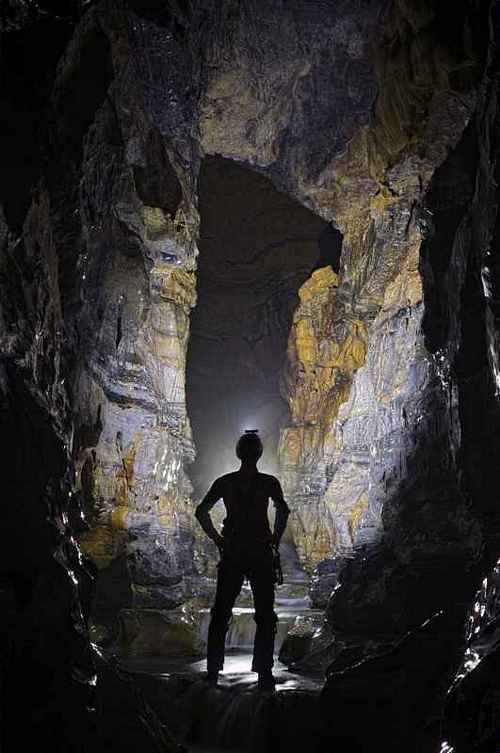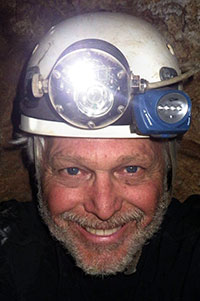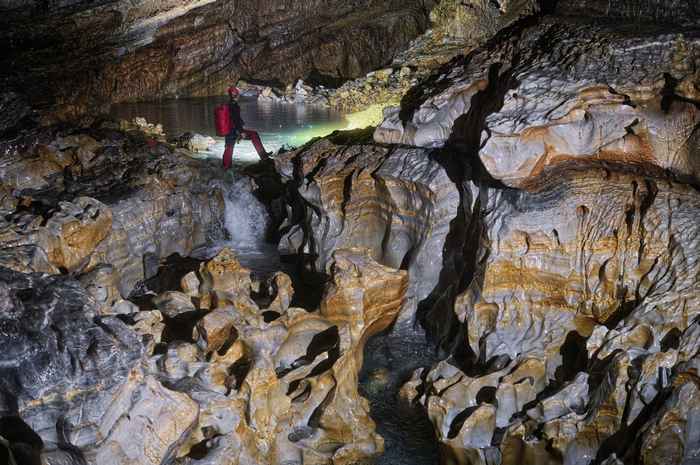|
By John Pint
 If you were to ask the average
person—anywhere in the world—for the name of a Mexican cave—you would
probably get in reply, “that cave with the giant crystals,” in
reference to La Cueva de
los Cristales connected to the Naica Mine 300
meters below the surface in Chihuahua, now celebrated thanks to
extensive coverage by NatGeo and Discovery channel. If you were to ask the average
person—anywhere in the world—for the name of a Mexican cave—you would
probably get in reply, “that cave with the giant crystals,” in
reference to La Cueva de
los Cristales connected to the Naica Mine 300
meters below the surface in Chihuahua, now celebrated thanks to
extensive coverage by NatGeo and Discovery channel.
During the years that Naica was drawing international attention, cave
explorers from all over the world were flocking to other points further
south in Mexico, for example to San Luis Potosí, Guerrero and Oaxaca,
areas which have long been considered “the new frontier of caving.”
Here cavers have a high likelihood of being among the first human
beings ever to boldly set foot where “no one has gone before.”
Maybe the best example of such an area is the Huautla Cave System
located near the city of Huautla de Jimenez in Oaxaca's Sierra Mazateca
mountains. Exploration began in 1965 and since then numerous
expeditions mapped over 75 kilometers of passages and found 20
entrances to the system. In the late winter of 2013, an international
team of cave divers entered the cave, rappelled through crashing
waterfalls down chasms as tall as skyscrapers and carried out eight
separate Scuba dives past “the mother of all sumps” to reach a depth of
-1554 meters, making Huautla the Western Hemisphere's deepest cave...
and now the longest of the 17 deepest caves in the world.
In 2015, 47 speleologists from seven countries (Mexico, USA, UK,
Australia, Poland, Switzerland and Romania) participated in a six-week
expedition to venture into parts of the system which had not yet been
explored.
 “We explored and mapped in two caves 700 meters
deep,” said veteran Huautla pioneer and Explorers Club member Bill
Steele. “You need a lot more than 700 meters of rope to reach those
points because you have horizontal traverses to do on the way
down...and it takes a whole week just to put the ropes in place.” “We explored and mapped in two caves 700 meters
deep,” said veteran Huautla pioneer and Explorers Club member Bill
Steele. “You need a lot more than 700 meters of rope to reach those
points because you have horizontal traverses to do on the way
down...and it takes a whole week just to put the ropes in place.”
Newly reorganized as PESH (Proyecto Espleleológico Sistema Huautla),
Steele's team now includes Mexican biologists who, during this one
expedition, discovered six new species of troglobitic life.
“We had paleontologists from INAH,” continues Steele, “and boy, were
they happy because they discovered Pleistocene (Ice Age) animals which
had fallen into a natural trap. All their bones were right there,
perfectly preserved, animals like giant ground sloths. It also appears
they found the bones of a gigantic bison (Bison antiquus).
Imagine: bison in the mountains of southern Mexico!”
During April of this year, PESH organized the third of ten planned
expeditions, from which Bill Steele has just returned.
“I'm home at last!” posted Steele on El Cinco de Mayo (May 5, 2016)
after a six-day drive from Huautla to Irving, Texas. “All I want to do
is rest and watch CNN.”
When asked what the PESH cavers had accomplished this year, Steele
stated that new passages had been discovered, bringing the length of
Sistema Huautla to 75.3 km, and its depth to 1560 meters. He added: “A
total of 46 speleologists from six countries participated this year
(USA, Mexico, England, Poland, Canada, and Switzerland). Five of these
were Mexican cave scientists working in the disciplines of geology,
biology, and paleontology. Of special note was the discovery of the
first complete skull of a Pleistocene sloth (Megalonyx Jeffersonii)
in Mexico, which has been extinct for over 12,000 years. It was
recovered by Ivan Alarcón of INAH. A lot was done in the Huautla area
caves, but There's much work remaining. I think only half of the cave
has been explored.”

It should be mentioned that Bill Steele has dedicated a great deal of
his time and energy to knowing and befriending the local people in the
Huautla area, who are mostly Mazatecs (“People of the Deer”). With the
help of Huautla English teacher, translator, and now beginner cave
explorer, Alma Rodríguez, Steele gave fourteen presentations about
PESH's work to around 800 students living in the area and actually took
many of the school teachers and children caving. Texas-based Whole
Earth Provision Company created a brochure in Spanish explaining all
about PESH and its goals, which the foreign speleologists found very
useful when encountering local people on their way to and from the
caves. “Next year we hope to have this brochure in Mazateco,” says
Steele with a smile.
The caves of Huautla are
located in valleys filled with rare flora and fungi, the most famous of
which is a mushroom called Psilocbe,
supposedly used by John Lennon and Bob Dylan under the spiritual
guidance of a local Mazatec curandera, Maria Sabina. In the past, the
curanderos have objected to explorers entering certain caves due to
ancient beliefs in “cave spirits”. Approaching this problem from a new
angle, this year Bill Steele arranged to meet with a Mazateco curandero
who performed a special ceremony for the speleologists “to get things
right with the cave spirits.”
Where does Huautla stand in
relation to the rest of the world's caves? “Way back in 1987,” says
Bill Steele, “a famous French caver named Phillipe Roullier approached
me deep inside the cave and said, with his German-Swiss accent, “Bill,
I do believe this is the most magnificent cave on earth.” Twenty-nine
years later—after numerous stupendous additions to the cave, Steele
hears more and more speleologists saying the same... “And wait till you
see what we discover next year!” he adds with a knowing smile.
Would you like to visit the Huautla caves from your living room,
without getting your clothes muddy? Have a look at Peshcaving.org,
a beautiful website with great pictures, and be sure to click on the
many links listed.
|

